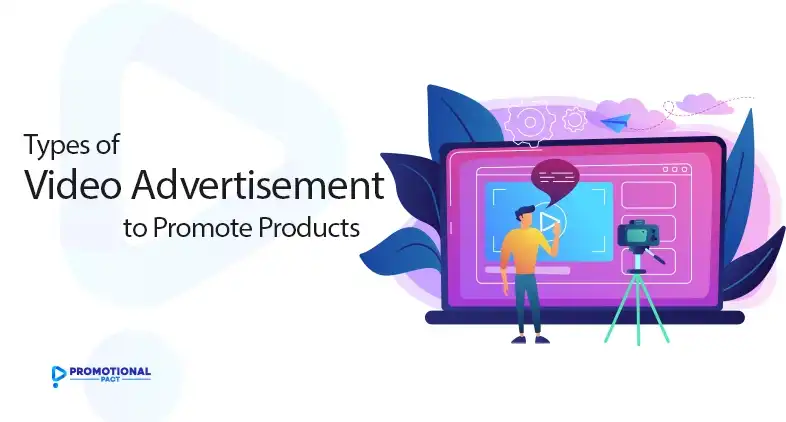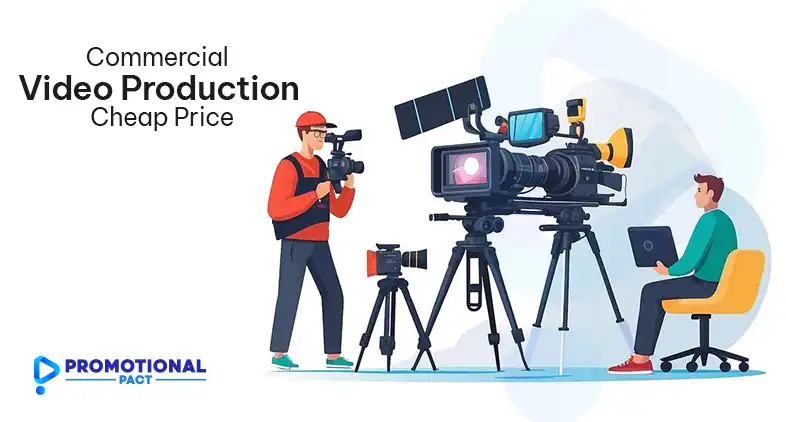With the power to boost conversion rates by up to 80%, video ads offer a dynamic and versatile medium for conveying messages, showcasing products, and building brand awareness. This article will explain various types of video advertisements, their unique characteristics, and how to leverage them effectively in your marketing campaigns.

Advantages of Video Advertising
Video advertising has come a long way since its inception. From the early days of television commercials to today’s sophisticated digital formats, video ads have evolved to meet the changing needs of advertisers and consumers alike. The rise of social media platforms, streaming services, and mobile devices has created new opportunities for brands to connect with their target audiences through compelling visual content.
One of the key advantages of video advertising is its ability to engage viewers on multiple levels. By combining visuals, audio, and motion, video ads can evoke emotions, tell stories, and demonstrate product features in ways that static images or text simply cannot match. This multisensory approach makes video ads particularly effective at capturing attention and leaving a lasting impression on viewers.
- In-Stream Ads
In-stream ads are perhaps the most familiar type of video advertisement to most viewers. These ads appear before, during, or after video content on platforms like YouTube, Hulu, or other streaming services. Let’s explore the three main types of in-stream ads:
Pre-Roll Ads
Pre-roll ads play before the main video content begins. They’re an excellent way to grab viewers’ attention right from the start. These ads typically range from 15 to 30 seconds in length, with some platforms offering shorter formats.
Best practices for pre-roll ads include:
- Keeping them short (15-30 seconds)
- Placing key messages and branding elements in the first 5 seconds
- Using attention-grabbing visuals or humor to prevent viewers from skipping
Mid-Roll Ads
Mid-roll ads appear during natural breaks in longer video content. They can be effective because viewers are already engaged with the content. However, they also risk interrupting the viewing experience if not placed thoughtfully.
To make mid-roll ads more effective:
- Time them to appear during natural pauses in content
- Keep them relevant to the surrounding context
- Use clear transitions to minimize disruption
Post-Roll Ads
Post-roll ads play after the main content has finished. While they may have lower view rates, they can be highly effective for viewers who have watched an entire video and are potentially more invested in the topic or content.
Tips for successful post-roll ads:
- Offer additional value related to the main content
- Use strong calls-to-action (CTAs)
- Keep them concise to maintain engagement
2. Out-Stream Video Ads
Out-stream video ads appear outside of video content, typically within article pages or social media feeds. These ads start playing automatically when they come into view, often muted until the user interacts with them.
Out-stream ads have gained popularity due to their high viewability rates and ability to reach audiences outside of video-specific platforms. These ads blend seamlessly with the content, playing only when visible and pausing when scrolled out of view.
To maximize the effectiveness of out-stream video ads:
- Design for silent viewing with clear visuals and on-screen text
- Keep messaging concise and impactful
- Ensure ads are relevant to the surrounding content
3. Native Video Ads
Native video ads are designed to match the look and feel of the platform they appear on, creating a more organic viewing experience. These ads are particularly effective on social media platforms like Facebook, Instagram, and Twitter, where they can appear in-feed alongside user-generated content.
A prime example of successful native video advertising is Airbnb’s “Made Possible by Hosts” campaign on Instagram. These short, visually stunning videos showcase unique travel experiences, blending perfectly with users’ regular Instagram feeds while subtly promoting Airbnb’s services.
Key considerations for native video ads:
- Adapt the ad format to match platform-specific styles
- Focus on storytelling rather than hard selling
- Use platform-specific features (e.g., Instagram’s poll stickers) to boost engagement
4. Bumper Ads
Bumper ads are ultra-short video advertisements, typically lasting just 6 seconds. These ads are non-skippable and often appear before or after longer video content. The brevity of bumper ads challenges advertisers to convey their message quickly and memorably.
Google’s own “Search On” bumper ad campaign demonstrated the format’s effectiveness by using rapid-fire visuals and text to highlight the power of Google search in everyday life. Despite their short duration, these ads achieved high brand recall and engagement rates.
Tips for creating effective bumper ads:
- Focus on a single, clear message
- Use striking visuals or unexpected humor
- Incorporate your brand early in the ad
[Picture suggestion: A series of 6 frames representing a 6-second bumper ad storyboard. Search for “Bumper ad storyboard example”]
5. Interactive Video Ads
Interactive video ads take engagement to the next level by allowing viewers to actively participate in the ad experience. These ads can include clickable elements, branching narratives, or mini-games that encourage viewer interaction and thus might offer better engagement.
To create compelling interactive video ads:
- Provide clear instructions for interaction
- Ensure the interactive elements enhance rather than distract from the message
- Offer meaningful choices or outcomes based on user interactions
6. 360-Degree and VR Video Ads
360-degree and virtual reality (VR) video ads offer viewers an immersive, exploratory experience. These formats are particularly effective for showcasing products, destinations, or experiences that benefit from a more comprehensive view.
Best practices for 360-degree and VR video ads:
- Guide viewers’ attention with visual cues or narration
- Ensure the entire 360-degree environment is interesting and relevant
- Optimize for both VR headsets and standard mobile/desktop viewing
7. Vertical Video Ads
With the rise of mobile-first platforms like TikTok and Instagram Stories, vertical video ads have become increasingly important. These ads are designed to fill the entire screen of a smartphone held vertically, providing a more native and immersive mobile viewing experience.
Tips for creating effective vertical video ads:
- Design with a 9:16 aspect ratio in mind
- Place important elements in the center of the frame
- Use large, readable text for any on-screen messages
[Picture suggestion: A comparison of horizontal and vertical video ad layouts on a smartphone screen. Search for “Horizontal vs vertical video ad comparison”]
8. Shoppable Video Ads
Shoppable video ads integrate e-commerce functionality directly into the video viewing experience. These ads allow viewers to click on products within the video to learn more or make a purchase, reducing friction in the buying process.
Key considerations for shoppable video ads:
- Ensure product integration feels natural within the video content
- Provide clear visual cues for clickable products
- Optimize the post-click experience for easy purchasing
9. Connected TV (CTV) Ads
Connected TV ads appear on streaming devices and smart TVs, allowing advertisers to reach audiences who have moved away from traditional cable television. These ads often benefit from the larger screen size of TVs while offering digital targeting capabilities.
To maximize the impact of CTV ads:
- Create ads that look good on larger screens
- Take advantage of advanced targeting options
- Consider interactive elements that work with TV remotes
10. Personalized Video Ads: Tailoring Content to Individual Viewers
Personalized video ads use data-driven techniques to customize ad content for individual viewers. This can include adapting the ad’s message, visuals, or offers based on factors like the viewer’s location, demographics, or past behavior.
Best practices for personalized video ads:
- Use data responsibly and transparently
- Ensure personalization adds genuine value to the viewer
- Test different personalization elements to optimize performance
11. Rewarded Video Ads
Rewarded video ads offer viewers an incentive (such as in-app currency or premium content access) in exchange for watching the full ad. This format is particularly popular in mobile games and apps. Duolingo’s rewarded video ad implementation is a great example of this format. Users can watch a short video ad to earn “lingots,” the app’s virtual currency, which can be used to unlock additional learning features.
Tips for effective rewarded video ads:
- Ensure the reward is valuable and relevant to users
- Keep ads relatively short (15-30 seconds)
- Provide a clear opt-in choice for users
How to Choose the Right Video Ad Type
Selecting the most appropriate video ad type depends on various factors, including your campaign goals, target audience, and budget. Here’s a quick reference table to help guide your decision:
| Ad Type | Strengths | Best For |
| In-Stream | High visibility, familiar format | Brand awareness, product launches |
| Out-Stream | High viewability, non-intrusive | Reaching audiences outside video platforms |
| Native | Seamless integration, less disruptive | Building brand affinity, storytelling |
| Bumper | Cost-effective, high reach | Quick messages, reinforcing larger campaigns |
| Interactive | High engagement, memorable experiences | Product demonstrations, complex messages |
| 360/VR | Immersive, unique experiences | Showcasing locations, products with spatial relevance |
| Vertical | Mobile-optimized, full-screen impact | Reaching younger audiences, mobile-first campaigns |
| Shoppable | Direct path to purchase, clear ROI | E-commerce, fashion, home goods |
| CTV | Reaching cord-cutters, TV-like experience | Brand campaigns, local advertising |
| Personalized | Higher relevance, improved performance | Retargeting, loyalty campaigns |
| Rewarded | Voluntary viewing, positive associations | Mobile app user acquisition, engagement |
Finally, don’t hesitate to experiment. A/B testing different ad types can provide valuable insights into what resonates best with your audience. Remember, the most suitable ad type may vary depending on your specific campaign objectives and target demographic.
Wrapping Up
Video advertising offers a wealth of opportunities for brands to connect with their audiences in meaningful and engaging ways. By understanding the various types of video ads available and following best practices for creation and measurement, you can develop video ad campaigns that not only capture attention but also drive real business results. As the landscape continues to evolve, staying adaptable and open to new formats and technologies will be key to success in video advertising.

